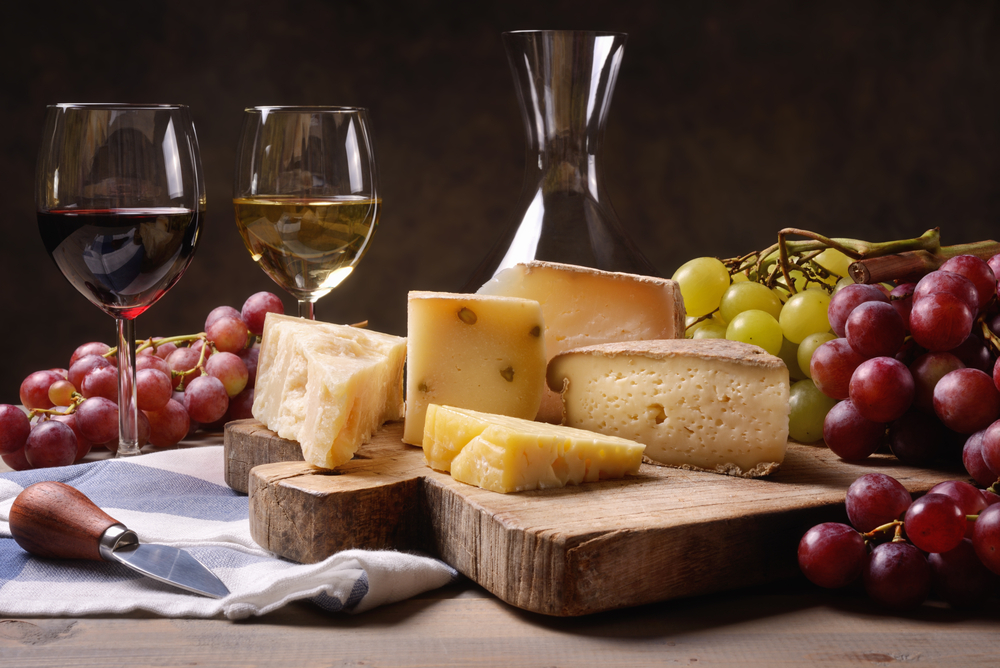If you’re like us, any wine will go with any cheese – the combination of the two is one of the best! But if you’re looking for more direction on what specific elements in the cheese and wine pair well together, then you’ve come to the right place.
A Few Basic Guidelines to Get Started
In general, white wines go better with cheese. This is because tannins in red wine can obscure the flavors of some cheeses and create unpleasant textures. However, if you have a highly tannic red wine, it will pair well with cheeses that are high in fat, in the same way that tannic wine works well with highly marbled steak. In a situation where you don’t know which cheeses are going to be served, or you want to pair a single wine with many cheeses, dessert wine is a good choice, as sweet wine is almost always a good bet with cheese.

Goat Cheese – Loire White Wines like Sancerre and dry Vouvray
Some of the most famous goat’s milk cheeses are from the Loire Valley in France, so why not pair them with Loire whites? Sauvignon Blanc from Sancerre or Chenin Blanc from Vouvray would both be great with a cheese like Chèvre.
Mozzarella – Champagne or Verdicchio
Good Mozzarella (i.e. better than what’s used on American fast-food pizza) is a treat that can be served on its own, as well as in an Italian dish. The rich fattiness of Mozzarella calls for white wine like Verdicchio from the Marche in Italy or Champagne. Sparkling wine would be particularly enjoyable, because the bubbles tend to refresh the palate while eating rich foods. Verdicchio has a minerality that would also be refreshing with Mozzarella. Plus, it’s always nice to have food and wine from the same place. Why not have Italian food with Italian wine?
Brie or Camembert – Champagne and White Burgundy
Soft cow’s milk cheeses like Brie and Camembert need a wine that’s not too strong, with some acidity and a little richness of texture. Try these cheeses with Champagne or white Burgundy. The nutty, toasty element in Champagne would be a great match, while the full-bodied, creamy character of a Burgundy Chardonnay would also be delicious.
Sheep’s Milk Cheese – Riesling and Sherry
Cheese made from sheep’s milk has a tangy flavor and slight saltiness. Both of these characteristics work well with slightly sweet and aromatic wines. Consider a Riesling from Germany or an Oloroso Sherry from the South of Spain.

Cheddar – California Red
Aged Cheddar has enough milk fat and texture to hold up to red wine. Since the USA produces so many great Cheddars, you should try one with an American red. Cabernet or Merlot from California would be excellent.
Parmigiano Reggiano – Chianti
The “King of Cheese” Parmigiano Reggiano has many imitators, but the genuine article comes exclusively from the Town of Reggio, in Italy’s Emilia Romagna. A great pairing here would be Sangiovese from Chianti. Sangiovese has a fine-grained tannic structure and earthiness to complement the richness and complexity of Parmigiano.
Gouda – Châteauneuf-du-Pape
Gouda is named after a town in the Netherlands, and is made from cow’s milk cheese. It’s often aged for long periods of time, allowing it to pick up complex nutty flavors and a dense texture, making it an excellent pairing with red wine. Châteauneuf-du-Pape from the Southern Rhône Valley in France would be a great match, being full bodied and rich.
Blue Cheese – Red Bordeaux and Sauternes
Blue cheeses like Stilton and Gorgonzola are traditionally served with sweet wine like the honeyed Sauternes, which is made from Sauvignon Blanc and Sémillon from Bordeaux. If you want a less sweet approach, you could also pair it with red wine from the Bordeaux region.
While the answer to pairing wines and different cheeses is subjective and multifaceted, it’s important to keep in mind that personal preferences are the main factor for determining a pairing. If you enjoy a particular wine with a particular cheese, then you’ve found a great pairing – regardless of what the experts say. To find your next bottle of discount wine online and explore cheese pairings, visit us at WTSO.com.



